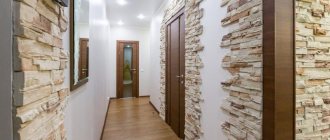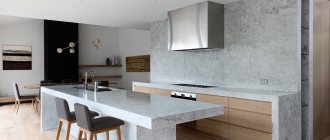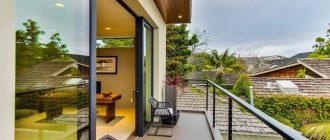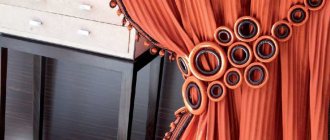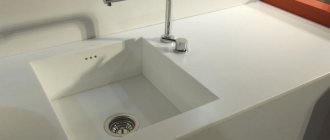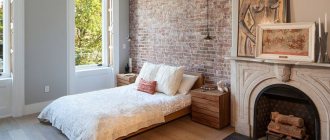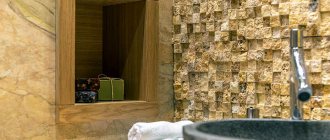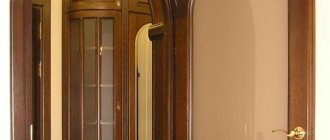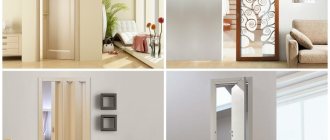Most often, decorative stone is used to decorate entrance openings of shops, cafes, and public buildings. This material not only gives the entrance a more attractive appearance, but also protects the walls from mechanical damage. But decorating the inside of the front door with decorative stone is also becoming increasingly popular.
Which stone to choose
Two types of decorative stones are used for cladding: natural and artificial.
Natural finishing material is obtained by processing natural rocks. This is expensive material. Therefore, many people prefer the more affordable artificial one. For its production, cheaper raw materials are used, for example, gypsum with additional additives. Externally, the facing material resembles natural stone.
In the construction market, such finishing materials are presented in a wide range. Therefore, many are interested in how to choose the right quality stone for finishing external entrance openings at an affordable price.
When purchasing artificial stone, first of all, you need to pay attention to the fact that all elements have the same size, texture, color scheme and look like natural material. In order for the coating to look as natural as possible after finishing, it is necessary to choose a material that combines more than two shades of the same color.
The presence of paint stains, growths, pieces of filler, other traces of the production process, as well as cavities with a diameter of more than 5 mm on the artificial finishing material is unacceptable.
For high-quality adhesion to the surfaces of the bases intended for finishing, the reverse side of the facing material must have grooves or roughness. This way, part of the adhesive composition will get inside the material and better hold it on the surface to be finished.
The end sides of artificial stones must be smooth so that after installation, smooth, invisible seams are formed. In this case, chips along the edges of the tiles should not exceed 4 mm. If finishing the front door with artificial stone involves the formation of visible seams, then chips are allowed up to 6 mm.
It is also important to pay attention to ensuring that the filling is uniform, i.e. without large particles. Otherwise, the unnaturalness of the material will be immediately noticeable, and the tile will be less durable. It is better to immediately abandon facing materials that do not have additional protection from negative influences.
Decorative gypsum tiles to look like stone and brick: pros and cons, installation and manufacturing
Gypsum is a soft, plastic and lightweight material, and these qualities determine the popularity of finishing materials made from it. Decorative tiles, the raw material for which is gypsum, are very popular; there are a huge number of texture and format variations. How not to make a mistake when choosing a manufacturer? Is it possible to make gypsum tiles to look like stone or brick yourself? What is the laying and grouting technology? We will consider all these questions further.
Quick navigation through the article
Advantages of choosing artificial material for finishing work
Artificial stone is available in different but standard shapes. Different product models differ in design solutions. Externally, the material can resemble not only natural stone, but also brickwork and other materials. Therefore, the main advantages of the facing coating are the ease of installation work and the ability to select the material for any design project.
The main advantages of finishing entrance openings to residential and public buildings with artificial stone:
- The coating does not affect the microclimate of the living space and has a special hygienic quality certificate;
- This is a fairly light material when compared with natural material. Therefore, it does not place a large load on the load-bearing walls of the building;
- Absolutely non-flammable material, fully meets established fire safety requirements;
- More expensive products are not inferior in strength to natural stone;
- The material is resistant to moisture, it can even be used to equip baths and saunas;
- Artificial stones have the same dimensions and absolutely smooth edges, which greatly facilitates finishing work;
- The components used to give the material natural shades penetrate its structure, so the coating does not fade, i.e. its original color remains unchanged throughout its service life.
Finishing doors with decorative stone is possible even for an inexperienced beginner. All decorative tiles have the same thickness and fit easily onto the surface. It is enough to control the evenness of laying the rows using a building level. Damaged artificial material can be restored.
Using curtains to block a doorway
The easiest way to decorate an interior passage where there was previously a door is to use curtains. These elements wonderfully distract attention from the door entrance, while complementing the interior of the room with notes of elegance and luxury.
An example of decorating a doorway with curtains
In this case, all that is required to decorate a doorway with curtains is to install a cornice and then hang the curtains. Anyone can do this work independently. However, it can be difficult to choose decorative curtains that will perfectly complement the doorway. If for some reason you are not able to choose the right curtains for the doorway, then you can use some advice from experienced designers. You can pick up these tips on the Internet or in any fabric store. As a rule, experienced specialists work here and are ready to give you clear recommendations.
Option for decorating the opening with curtains
Important. When choosing to decorate a doorway with curtains, it is recommended to hide the presence of a cornice as much as possible. In this case, there will be a visual feeling that this element is completely absent here.
Rules for finishing work
To decorate doorways with decorative stone, there are some architectural requirements that must be observed for high-quality finishing work:
- The door opening is evenly finished with material over the entire wall surface. The lower part of the cladding should look more massive in contrast to the upper;
- When making masonry, it is imperative to take into account the curvature of the edge of the entrance opening, ensure the evenness of the seams, and the relief pattern of the coating. All seams must be symmetrical to each other, incl. relief drawing. Only in this case will the design project have an absolutely complete natural look;
- It is also necessary to maintain the symmetry of the facing of both sides of the opening to each other;
- Wood products that suit the style are perfectly combined with artificial stone. For example, polished wooden panels can be used with smooth decorative stone, and decorative elements with a rough wood structure can be used with stones that have a rough surface.
Design fantasy
When decorating a doorway, you can bring various design ideas to life. After all, decorative stone imitates different surfaces.
Imitation of natural stone, sandstone and pebbles is suitable for rooms with a lot of flowers, wicker furniture, wooden products and other natural elements.
The original solution is to imitate the entrance to a cave. This option will lead to a visual increase in room space.
The door can act as a passage to a medieval castle. This imitation is the optimal solution when the house is dominated by antique furniture with paintings and other rare items.
The most popular is imitation brickwork, which is distinguished by its variety of colors and textures. Decorative coatings, which are characterized by a transition from one color to another, are in particular demand.
Preparatory work
The excellent combination of decorative stone with wood allows it to be actively used for cladding entrance and window openings. The technique of laying this material on a wall surface is similar to the technology of finishing bases with ceramic tiles.
Finishing work, as a rule, begins with preparing the work area, necessary consumables and tools. From the bases that will be finished, the old finish and bulges are first removed, existing cracks are sealed, and the surface is leveled.
For better adhesion to the facing coating, wall surfaces after preparation are primed in two layers. The primer mixture can be purchased at any hardware store. Before use, the composition must be thoroughly mixed. The facing tiles are laid only on a completely dry surface.
Before starting masonry, the products are laid out on a horizontal surface and selected according to color shades and patterns. Individual elements of the facing material are specially painted by manufacturers in different shades of the same color so that the coating resembles natural stone as much as possible. Therefore, it is important to ensure that the color transitions of two nearby tiles are smooth.
If materials with a decorative pattern are used for cladding, you must try to match the individual elements to each other so that the finished coating does not end up with too long vertical and horizontal lines (seams). Therefore, it is recommended to first lay out all the material on the floor and play with the pattern, rearranging and swapping different elements.
If necessary, artificial stone can be cut to the required size. To do this, it is recommended to use a special tool - electric cutting for stone and tiles. Cut edges are sanded if necessary.
Self-production
If the volume of cladding is large, then it makes sense to purchase molds (or make them yourself) and make the tiles at home.
Video on how to make it at home: Decorative gypsum tiles have a wide range of applications. But do not forget about the disadvantages when choosing a facing material. Consider not only the relevance of gypsum in the context of the interior idea, but also the quality of the material. When planning to resurface your work fireplace, don't skimp on the time it takes to find a good manufacturer. Low-quality tiles at high temperatures simply will not withstand the heat and will peel off, or even crack. Sometimes it is useful to apply glue twice, including on the slab. This will increase adhesion and, subject to other requirements, guarantee the durability of the cladding.
- What are clinker tiles? Pros and cons, use and installation
- Seamless tiles: what are they, pros and cons, features of installation in the bathroom
- Kitchen tile design (19 photos)
>
Preparation of adhesive solution
In order to reliably fix the finishing material on a vertical wall surface, its reverse side, which will be adjacent to the base, must be rough. At the same time, it is equally important to properly prepare the adhesive composition itself.
To do this, it is recommended to use a construction mixer, which is specially designed for preparing mixtures. With its help, the composition is thoroughly mixed until smooth. You need to stir the solution for about 6 minutes, maybe a little longer, but no less.
Proportions: water – 200 ml; dry mixture – 1 kg.
After preparing the solution, it must be used within 10 minutes, so it dries quickly. Therefore, the mixture must be prepared in small portions, depending on the laying speed of the master. Each package of dry mixture contains instructions for preparing the solution and rules for its use.
Suture technology for laying artificial stone
It is not recommended to wet the decorative stone before laying it. Excess moisture contributes to the deterioration of the quality of the adhesive composition.
Laying must begin from the corner of the wall. Before laying the slab, prepared glue is applied to the base to be finished. A comb spatula is used for this. Next, a finishing coating element is applied and lightly pressed against the wall.
The most difficult thing in this process is finishing the corners and forming identical seams.
There are two ways to form a corner: the first is to connect corners using the principle of brickwork, the second is to trim each side tile at an angle of 45 degrees. The first option is simpler, but the appearance of the finished coating is less attractive.
Decorative stones are glued to the wall surface in the same order as they are laid out on the floor (the pattern must match). It is necessary to take into account that each texture has its own width of the seam between the tiles.
To ensure smooth seams, it is imperative to use special plastic inserts. A set of such products can be purchased at any hardware store. It is better to buy them immediately along with the facing material.
After completion of masonry work, the seams are additionally filled with special jointing designed to seal the surface. The jointing gives the cladding a holistic, harmonious look. How to prepare this composition can be found in the instructions provided by the manufacturer on the packaging.
Why plaster?
Gypsum tiles have many advantages. But there are also disadvantages. Decide for yourself whether to choose it or prefer regular tiles, using the list of pros and cons.
Advantages of gypsum tiles
- Easy to install - no special skills required.
- Decorative functions. Beautiful imitation of natural stone or brick.
- Low cost, from 450 RUR/m².
- Light weight. You can even lay it on plasterboard walls. Lighter than cement decorative tiles.
- Environmental friendliness. Gypsum is a natural material.
- "Warmth" of the material.
- Possibility of self-production.
Wall decoration in the bedroom.
Disadvantages of decorative tiles
- High water absorption and low frost resistance. Gypsum tiles strongly absorb water, which forces them to be used only for interior decoration in dry rooms.
- Difficulty in cleaning. Over time, dust accumulates on the embossed surface, which is difficult to remove. To protect against dirt, the tiles are coated with a protective varnish.
- The risk of purchasing low-quality products. The quality of gypsum tiles largely depends on the brand of raw materials. Unscrupulous manufacturers often skimp on the raw material, which leads to rapid destruction of the slabs.
Gypsum tiles on the facade will collapse within 1 year.
Cheap plaster "Kasavaga" will not last even 1 season on the street.
Seamless material laying technique
This is a rather painstaking technology for laying decorative stone, but the finishing itself is much faster than with the suture technique. In this case, all coating elements are applied tightly to each other. The result is a monolithic coating.
The adhesive or liquid nails are applied directly to the back of the product. When performing seamless masonry, it is necessary to immediately remove excess glue, as it hardens quickly; it is especially necessary to ensure that it does not get on the front side of the coating. The glue is prepared in such a volume that the master can use it within a maximum of 25 minutes.
Before laying tiles, it is imperative to install a boundary profile under the building level. This is necessary to obtain clear boundaries when laying decorative elements from top to bottom. And when finishing from bottom to top, the profile will serve as a reliable basis.
Cladding the wall, as in the first case, starts from the corner, but it is only done much faster, since there is no need to ensure the evenness of the seam. All factory facing materials of the same batch are produced strictly the same size, with smooth edges. Therefore, during the installation process, the individual elements fit tightly to each other without additional trimming or adjustment.
The final stage of finishing work is impregnation of the finished coating with a special composition that increases the strength of the structure and resistance to adverse external influences.
So we told you how to properly decorate your front door with decorative stone with your own hands. Numerous photos in the article only confirm that this is one of the most beautiful ways to decorate the front doorway.
